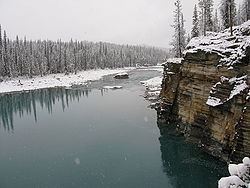Length 1,231 km Discharge 623 m³/s | - elevation 205 m (673 ft) Basin area 95,300 km² | |
 | ||
- elevation 1,520 m (4,987 ft) (foot of glacier) - average 783 m/s (27,650 cu ft/s) - max 4,790 m/s (169,160 cu ft/s) - min 75.0 m/s (2,650 cu ft/s) Similar | ||
The Athabasca River (French: rivière Athabasca) originates from the Columbia Glacier of the Columbia Icefield in Jasper National Park in Alberta, Canada. The impressive and scenic Athabasca Falls is located upstream about 30 km (19 mi) from the Jasper townsite.
Contents
- Map of Athabasca River Improvement District No 12 AB Canada
- Origin of name
- History
- Heritage
- Course
- Effects of coal and oil extraction
- Coal mine spill
- Oil spills
- Legacy
- References
Map of Athabasca River, Improvement District No. 12, AB, Canada
Origin of name
The name "Athabasca" comes from the Woods Cree word aðapaskāw, which means "[where] there are plants one after another", likely a reference to the spotty vegetation along the river.
History
Sekani, Shuswap, Kootenay, Salish, Stoney and Cree tribes hunted and fished along the river prior to the European colonization. From about 1778, the Athabasca River, the Clearwater River, which enters the Athabasca River from the east at Fort McMurray, and the Methye Portage were part of the main fur trade route from the Mackenzie River to the Great Lakes. See Canadian Canoe Routes (early).
David Thompson and Thomas the Iroquois travelled through Athabasca Pass in 1811. In 1862, the Athabasca Springs area was crossed during the Cariboo Goldrush by the Overlander Party.
Heritage
This river was designated a Canadian Heritage River for its importance to the fur trade and the construction of railways and roads opening up the Canadian West, as well as for its natural heritage.
Course
The Athabasca River originates in Jasper National Park, in an unnamed lake at the toe of the Athabasca Glacier within the Columbia Icefield, between Mount Columbia, Snow Dome, and the Winston Churchill Range, at an elevation of approximately 1,600 metres (5,200 ft).
The river flows along icefields and through gorges, offering wildlife habitat on its shores and adjacent marshes. Throughout its course, it flows through or adjacent to numerous national and provincial parks, including Jasper National Park, Fort Assiniboine Sandhills Wildland Provincial Park, Hubert Lake Wildland Provincial Park, La Biche River Wildland Provincial Park, Grand Rapids Wildland Provincial Park, Richardson River Dunes Wildland Provincial Park, and Wood Buffalo National Park. Its course is marked by rapids, impeding navigation southwest of Fort McMurray.
The Athabasca River travels 1,231 km (765 mi) before draining into the Peace-Athabasca Delta near Lake Athabasca south of Fort Chipewyan. From there, its waters flow north as Rivière des Rochers, then joining the Peace River to form the Slave River that empties into Great Slave Lake and discharges through the Mackenzie River system into the Arctic Ocean. The cumulative drainage area is 95,300 km2 (36,800 sq mi).
Numerous communities are located on the banks of the Athabasca River, including Jasper, Brule, Entrance, Hinton, Whitecourt, Fort Assiniboine, Smith, Athabasca, Fort McMurray, and Fort MacKay.
Effects of coal and oil extraction
An independent study has concluded that the Athabasca River contains elevated levels of pollution downstream of the Athabasca oil sands. Testing has shown this portion of the river contains mercury, lead and 11 other toxic elements.
Coal mine spill
On October 31, 2013, one of Obed Mountain coal mine's pits failed, and from between 600 million to a billion liters of slurry poured into the Plante and Apetowun Creeks. The plume of waste products then joined the Athabasca River, travelling downstream for a month before settling in Lake Athabasca near Fort Chipewyan, over 500 km (310 mi) away.
Oil spills
Owing to its proximity to the Athabasca Oil Sands, the river has seen significant amounts of energy infrastructure constructed along its course. On June 6, 1970, a pipeline operated by Great Canadian Oil Sands, the precursor to Suncor and the earliest commercial extraction operation, ruptured near the banks of the river. The total spill volume was estimated by Great Canadian Oil Sands at approximately 1,190 barrels of oil.
Legacy
The Canadian Heraldic Authority named the position of Athabaska Herald after the river.
